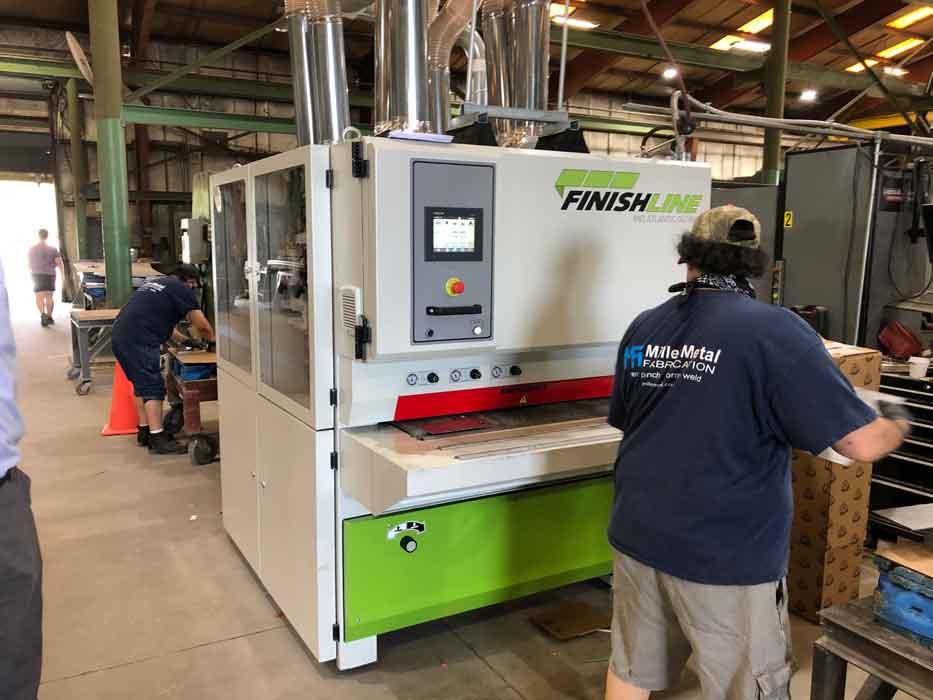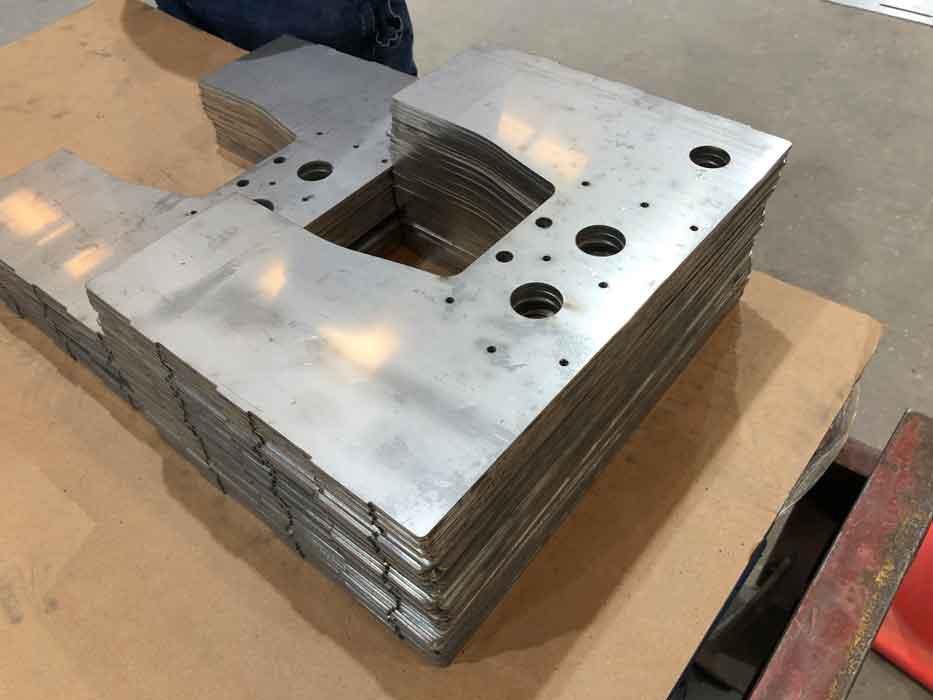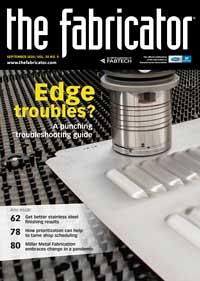Editor-in-Chief
- FMA
- The Fabricator
- FABTECH
- Canadian Metalworking
Categories
- Additive Manufacturing
- Aluminum Welding
- Arc Welding
- Assembly and Joining
- Automation and Robotics
- Bending and Forming
- Consumables
- Cutting and Weld Prep
- Electric Vehicles
- En Español
- Finishing
- Hydroforming
- Laser Cutting
- Laser Welding
- Machining
- Manufacturing Software
- Materials Handling
- Metals/Materials
- Oxyfuel Cutting
- Plasma Cutting
- Power Tools
- Punching and Other Holemaking
- Roll Forming
- Safety
- Sawing
- Shearing
- Shop Management
- Testing and Measuring
- Tube and Pipe Fabrication
- Tube and Pipe Production
- Waterjet Cutting
Industry Directory
Webcasts
Podcasts
FAB 40
Advertise
Subscribe
Account Login
Search
Miller Metal Fabrication keeps trying new things
Fabricator finds that embracing change is the key to continuous improvement
- By Dan Davis
- September 17, 2020
- Article
- Laser Cutting

Miller Metal Fabrication’s TRUMPF 10-kW TruLaser 5040 has added new laser cutting capacity for the fab shop. Images provided by Miller Metal Fabrication
Growing up on a farm, Martin W. Miller learned that if you needed to improve a situation, you were responsible for improving it.
The classic example is fixing a key piece of equipment, like a combine. If the combine is not running and it needs to be ready for harvesting, the farmer better get to work on the repairs. Waiting on a mechanic from the local equipment dealer is a gamble, because everyone wants their tractors and combines worked on prior to harvest. There is no excuse for not having a running combine, so the farmer has to be skilled enough to make it happen.
Miller had that type of creative mind, according to his son Martin Miller III, and it helped him to come up with new ways to do things. For example, when a local major food manufacturer needed machinery to help automate pretzel-making, the company reached out to Miller, who built them a pretzel-twisting machine. That was the beginning of a new business, but a few years later Miller recognized that not everyone needed a pretzel-twisting machine. As a matter of fact, a lot of his customers required his services only when a new piece of machinery was needed. That didn’t leave a whole lot of opportunity to grow the business.
Realizing he was good at fabricating things, Miller decided to focus on his talent and not on an end product. He built the parts and assemblies that others didn’t want to build. With the purchase of CNC plasma cutting and punching technology, Miller Metal Fabrication was born in the mid-1980s.
Laser cutting technology, however, changed the trajectory of the business in the mid-2000s. Miller had always been interested in finding new ways of doing things, and laser cutting was too big of a technological change to ignore.
A New Pace of Manufacturing
“We had started looking through The FABRICATOR at the time and saw some of the advertising for the TRUMPF lasers. So we had discussions back and forth between us,” said Miller III, referring to his dad, his two brothers in the business, David and Paul, and Dave Morris, the company’s vice president, who is now semiretired. “So in 2006 we bought our first laser machine and that kind of changed our world as far as production manufacturing.”
That one piece of equipment changed the dynamic of the shop floor, as Miller Metal could now produce 2D blanks faster than it ever could before. It was up to the rest of the shop to catch up.
In a way that same dynamic exists today. Miller Metal has five TRUMPF laser cutting machines, including an 8-kW TruLaser 5030 fiber laser purchased in 2016 and a 10-kW 5040 TruLaser 5040 with a 6-ft. 8-in. by 13-ft. 4-in. table and automated material loading/unloading. To keep up with the blanks coming off the lasers, the shop has 13 press brakes, six of which are TRUMPF TruBend models. Laser cutting and press brake forming are done over three shifts.
In the spirit of trying to find a new way of doing things, Miller III said the company started offline programming of the press brakes about 18 months ago. What began as an effort to find more efficiency in the bending department also delivered another benefit.
“For the most part with the offline programming, our bend repeatability and holding of tolerances has gotten probably 40% to 50% better over the past several months,” Miller III said. “It takes us a little more time in the office, and we’ve added more office people. So it’s a bit of a balance.”
Not Afraid to Adjust After an Adjustment
The focus on finding efficiencies not only on the shop floor but also the front office is nothing new for Miller Metal. It worked with a consultant from the Delaware Manufacturing Extension Partnership in 2007, and the recommendations really “shook us up a bit,” Miller III said.
At that time the front office was organized like in most other companies, with one person being responsible for one activity. The head of purchasing handled all raw material acquisitions. All quoting went through the lead estimator. The lean consultant had other ideas, however.
The consultant recommended that a “project manager” be the one point of contact for all things related to a job. That project manager handled the quote, purchasing of material, and even design, which meant that a lot of people were sent off to learn SolidWorks. The theory was sound in that one person would have all of the answers about that one job. Reality showed that it was an extreme change that had its bumps when it came to execution.
“It was an extreme pendulum swing over that way,” Miller III said.
The benefits became evident almost right from the start. Project managers didn’t need to rely on the quoting department to turn around estimates for an antsy client or on the purchasing department to expedite a material order for a hot job. They also could hand-hold those hot jobs as they worked their way through the shop. The buck always stopped with those project managers, which made communication a bit easier.
Unfortunately, the process wasn’t the most efficient way to approach all of those support activities to metal fabricating. For instance, one project manager might order a sheet of 0.25-in. hot-rolled steel, and another one might call up the service center for five sheets of the same material. A few hours later, two different trucks would pull up, waiting to be unloaded. Also, finding individuals with adequate design skills to really maximize that project manager role was difficult.
After several months of this arrangement, Miller Metal knew it needed to come back somewhat. “We kind of went back to our roots a bit,” Miller III said.
The company set up a design department to help out with 3D modeling for quoting and work instructions. A purchasing manager was hired, and all material requisitions came through him. But the role was tweaked in a nontraditional way, according to Miller III, because the purchasing manager also nests all the jobs. He can see the demand, bundle similar types of jobs with similar deadlines, and maximize the material usage. He also has help from others, who handle the creation of CAM programming for the laser cutting and punching machines.
“It’s a little different than before, but works better for us now,” Miller III said.
This willingness to invest in new technology and shake up internal processes has proven to be a recipe for success over the years, Miller III said. The company actually grew during the Great Recession and survived 2016 when tariffs went into effect, increasing material costs. Even now in the midst of the COVID-19 pandemic, the company has remained busy, making the most of Gov. John Carney’s proclamation of metal manufacturing businesses as being “essential” in the fight against the virus. In fact, the metal fabricator proved to be a valuable partner in a major effort to build ventilators during the early days of the COVID-19 outbreak on the East Coast.

The FINISHLINE metal finishing machine proved to be a useful tool when it came to turning around laser-cut stainless steel parts that needed to have microburrs removed and edges rounded for a ventilator application
A Race to the Finish
All eyes were on New York City in March as the metropolitan area was the first major epicenter of the COVID-19 crisis in the U.S. In addition to personal protective equipment, city officials and medical professionals also sent out a call for ventilators. In those early days, many who were admitted into the hospital with the virus struggled mightily with breathing, and the lack of access to an inventory of ventilators worried everyone.
Spurred on by news coming from Italy and the call for manufacturing help, some New York City engineers from firms like NewLab and 10XBeta got to work and developed a design for a “bridge” ventilator, also called an automatic resuscitator. It’s a streamlined ventilator that is designed to help less critically ill patients breathe. It also happens to cost about a tenth of a standard ventilator, which starts at around $30,000. After receiving expedited approval from the Food and Drug Administration, product designers reached out to local manufacturing contacts and found Boyce Technologies, a local manufacturer of safety and security equipment for the city’s mass transit system. Boyce Technologies then found Miller Metal to help with the red-hot manufacturing effort.
Miller Metal was charged with making chassis components for the ventilator. Laser cutting the blanks would be no problem given the shop’s equipment. Finishing the parts coming off the laser cutting machines, however, was going to be a challenge. The fabricator had a single-head grinding machine, but that was primarily used to put a grain on metal surfaces. Grinding off the microburrs that are often left on fiber laser-cut parts and rounding edges of the stainless steel parts to meet medical standards was going to have to be done manually, which was going to take more time than Miller Metal had.
“We had three days to order 200 sheets of stainless steel and have the parts cut, deburred, and bent,” Miller III said. “Even with 20 people sanding it, you’re not going to get the job done in two days. You’re probably going to need a week.”
Fortunately, around the same time, the company was entertaining the thought of investing in an automated finishing system. The fab shop had been in contact with its equipment dealer, Mid Atlantic Machinery, about its FINISHLINE machine, but it wasn’t exactly ready to make the investment—at least until the ventilator job came along.
That led Miller Metal to ask for a test to see just how fast and effective the finishing equipment would be. In early May Mid Atlantic Machinery delivered the machine, which has a 43-in.-wide working window, and set it up between the newest laser cutting machines.
“As soon as the machine was installed, we were running parts in production,” said John Rutkiewicz, Mid Atlantic’s FINISHLINE specialist.
The 11- to 14-ga. stainless steel parts were about 14 in. wide by 18 to 20 in. long. An operator fed the first one through and proceeded to feed another 1,099 parts through the machine. In 105 minutes, all of the parts were deburred and had rounded edges. Miller III said that if the process had been done manually, it probably would have taken a 10-person crew a full shift to match the results of the automated finishing machine.
“I don’t know if we would have bought the machine without that demonstration, but we were glad to see it in action. It was kind of the pushing-off point for that machine,” Miller III said. The fabricator also used the machine to deburr and edge-round some 0.25-in. stainless steel base plates.
Rutkiewicz said the finishing machine has four heads that can handle not only deburring and edge rounding, but also oxide removal on edges for better paint adhesion, deslagging of plasma-cut parts, and graining of metal surfaces. Because Miller Metal was more interested in accentuating the deburring and edge rounding, the machine was staged with an abrasive belt (65 to 70 Shore hardness) for deburring, then a brush for edge rounding, then another brush, and finally a softer abrasive brush (35 Shore hardness) for a specified grain. The ventilator parts needed to be run on only one side, so they didn’t need to be flipped and fed through the machine again.
Kevin Kilgallen, Mid Atlantic Machinery president and the first sales representative to introduce the TRUMPF laser technology to Miller Metal back in the 2000s, said he knew the machine would make an instant impact at the metal fabricating company, but he also believes that the machine will have an additional impact down the road as the deburring process is now streamlined. In particular, he pointed to the machine’s automatic thickness adjustment, where a sensor determines the material thickness and moves the belts and brushes to deliver specified results. That and the machine’s CNCs, which can store up to 250 finishing recipes, promise to help even less experienced employees get up to speed on the machine in a few days.
Miller III said the finishing equipment enabled the company to meet its obligations to deliver the ventilator parts in its three-day time frame and it’s hoping to find similar time savings on other projects because the bottleneck of manual deburring has been removed. Additionally, he said he was intrigued by the polishing and graining capabilities, some he called “a science to its own.”
Room to Grow
The automated finishing machine is not the only piece of equipment that Miller Metal has added recently. It installed Peddinghaus’ Ocean Avenger single-spindle drill line this summer. The equipment will be useful with the company’s structural steel work, which never dominates fabricating activities at the company, but never really completely disappears either.
Miller III said that kind of sums up Miller Metal nowadays. People come to the company because they know that it’s a one-stop shop for their fabricating needs, which also may include machining and welding.
Remarkably, all of this metal fabricating activity is taking place in a 35,000-sq.-ft. facility. “Our poor shipping department is almost out the door,” Miller III said. The shipping department lost some of its space to the new drill line.
Another change is coming in 2021 when Miller Metal moves into a new, 60,000-sq.-ft. facility just down the road. It’ll have more elbow room to try new things and make necessary adjustments along the way. It’s not the smoothest way to run a manufacturing business, but no one really gets into the trade to take it easy. Whether it’s a harvest or a delivery date, the job has to get done, no matter what it takes.
About the Author

Dan Davis
2135 Point Blvd.
Elgin, IL 60123
815-227-8281
Dan Davis is editor-in-chief of The Fabricator, the industry's most widely circulated metal fabricating magazine, and its sister publications, The Tube & Pipe Journal and The Welder. He has been with the publications since April 2002.
subscribe now

The Fabricator is North America's leading magazine for the metal forming and fabricating industry. The magazine delivers the news, technical articles, and case histories that enable fabricators to do their jobs more efficiently. The Fabricator has served the industry since 1970.
start your free subscription- Stay connected from anywhere

Easily access valuable industry resources now with full access to the digital edition of The Fabricator.

Easily access valuable industry resources now with full access to the digital edition of The Welder.

Easily access valuable industry resources now with full access to the digital edition of The Tube and Pipe Journal.
- Podcasting
- Podcast:
- The Fabricator Podcast
- Published:
- 04/16/2024
- Running Time:
- 63:29
In this episode of The Fabricator Podcast, Caleb Chamberlain, co-founder and CEO of OSH Cut, discusses his company’s...
- Trending Articles
Tips for creating sheet metal tubes with perforations

Are two heads better than one in fiber laser cutting?

Supporting the metal fabricating industry through FMA

JM Steel triples capacity for solar energy projects at Pennsylvania facility

Omco Solar opens second Alabama manufacturing facility

- Industry Events
16th Annual Safety Conference
- April 30 - May 1, 2024
- Elgin,
Pipe and Tube Conference
- May 21 - 22, 2024
- Omaha, NE
World-Class Roll Forming Workshop
- June 5 - 6, 2024
- Louisville, KY
Advanced Laser Application Workshop
- June 25 - 27, 2024
- Novi, MI



























